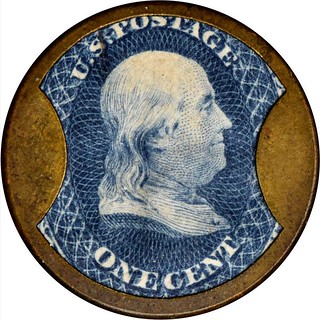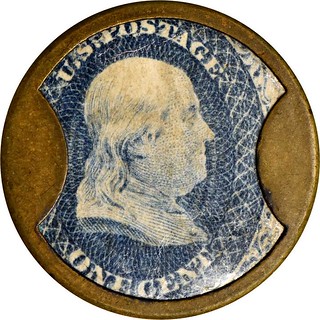
PREV ARTICLE
NEXT ARTICLE
FULL ISSUE
PREV FULL ISSUE
THE BOWERS COLLECTION OF ENCASED POSTAGE STAMPSDave Bowers wrote a blog article about Civil War numismatics and forming his reference collection of U.S. encased postage stamps, which is up for sale at next week's ANA show. -Editor

I have always loved encased postage stamps. When I was a teenager I began to study them, seeking biographies of the various merchants. As time went on I helped form several major collections, including for Jim Ruddy and, in part for John J. Ford, Jr. With Mike Hodder taking the lead, I was co-author of The Standard Catalogue of Encased Postage Stamps published in 1989. My gosh, that was 30 years ago! The book was a best seller and has been out of print for quite a few years. Today on the antiquarian book market, copies sell for more than they did originally! As you read these words I am gathering expanded information for a new book on the subject, perhaps for publication next year. Meanwhile, I have completed the manuscript for a new specialized book to be published by the Token and Medal Society next year: The Story of DRAKE’S PLANTATION BITTERS: A 19th Century Cure-All. I have collected Drake’s items for many years, included bottles, encased postage stamps (here offered), almanacs, and more. I have often thought about doing a book on Dr. J.C. Ayer, but probably will not. Encased postage stamps are an interesting chapter in the annals of numismatics. In the first decade of the 20th century they were one of the most actively collected series. Far more people collected these than did Morgan silver dollars by mintmarks. In 1901 a typical Drake’s Plantation Bitters stamp cost more than a Mint State 1893-S dollar (today worth several hundred thousand dollars). Such things contribute to the lure and lore of numismatic history. As to encased postage stamps, these were among several forms of substitute or emergency currency issued during the second year of the Civil War. By late 1861 the outcome of the war was uncertain. Both the Union and the Confederate States of America forces could claim victories. In England, the destination for much of the cotton produced in the South, CSA bonds denominated in British pounds found a ready sale. Citizens became alarmed, and gold coins were hoarded to the extent that by January 1862 they were no longer paid out by banks. Problems continued as the United States Treasury scrambled to raise funds by issuing Legal Tender Notes not redeemable in silver of gold coins. By late spring, all silver coins had disappeared from circulation. In the second week of July it happened: there were no coins at all in circulation. Even the copper-nickel Flying Eagle and Indian Head cents were gone—into the hands of concerned citizens and speculators. Some hoarders had tens of thousands of them, in one instance causing a floor to buckle from the weight. It was no longer possible to buy a newspaper or a glass of beer, to get a haircut, or pay for a ride on a horse-drawn car. Rising to the occasion, Congress on July 17 1862, made ordinary postage stamps legal tender! These flimsy, tiny, gummed pieces of paper soon became dirty. They stuck together in hot, humid summer weather, and were a great inconvenience to use as a daily medium of exchange. To make transactions with postage stamps easier, many merchants and others had little envelopes printed with a denomination such as 50 cents lettered on the outside and containing an equivalent face value in loose stamps. Others had tickets and scrip notes printed with the stated value of an envelope’s contents as well as with their business addresses, so once in circulation there was a place to redeem them (for other stamps or paper). United States Treasurer Francis E. Spinner experimented with the idea of pasting stamps on rectangular cards to create money of recognizable value in more convenient form than loose paper. This led to the creation of Postage Currency, a new class of paper money, printed by contractors in New York City and issued in sheets with perforations that could be torn apart. These were made in denominations of 5¢, 10¢, 25¢, and 50¢ and bore the designs of contemporary stamps printed within a border, and with added inscriptions. The first Postage Currency notes were issued through Army paymasters in August, then to the general public in September. Once quantities reached circulation this eliminated the need for stamps singly or in envelopes. On August 12, 1862, John Gault, an entrepreneur who had recently moved to New York City from Boston, was awarded a patent for the encased postage stamp (as offered here, and also by Kirkpatrick & Gault). These consisted of a two-part brass frame, the obverse having a pane of clear mica positioned over a postage stamp. The reverse was embossed with an advertising message for different services, products, or other facilities. Denominations included 1, 3, 5, 10, 12, 30, and 90 cents. The lower denominations were the most popular. These bright little tokens reached circulation soon after the patent date. The New-York Daily Tribune, August 30, 1862, included this under the heading of “City Items”: “A substitute for coin—A friend has shown us a light circular metallic sheath of white metal, for postage stamps of large and small denominations, the face of the stamp being covered with a transparent sheet of mica. It is slightly smaller in diameter than a quarter of a dollar, and is designed to take the place of small silver coin. “The metallic back is to be stamped with the advertisement of the houses ordering them. Their price to purchasers is $20 or less a thousand; to the general public, only the value of their face. The idea is not a bad one.”
These encased postage stamps served their purpose well and were common in circulation in the East and Midwest into 1863. In that year cent-size copper (mostly) and brass tokens minted by shops in Cincinnati, New York, Chicago, and elsewhere became dominant. These were of two basic types: (1) Patriotic with a flag, cannons, military leaders, etc., and (2) Store cards issued by over 900 different merchants. Wholesaling at $6 to $7 per thousand tokens, they were inexpensive. In early 1863, when such tokens flooded the country, the issuance of encased postage stamps ended. Slightly more than 30 merchants and products were advertised on encased postage stamps, with Drake’s Plantation Bitters being one of the largest issuers. Today the lower denominations are often seen and are readily collectible. The higher values are scarce. When I formed my reference collection, I determined to acquire a “nice” example of the various issuers.. At age 80 I have been deaccessioning favorites such as these, for another generation to enjoy. I hope you as a successful bidder will share my interest. To read the complete article, see:
Here are a few example lot in the sale. Rarely does such a great selection of encased postage come on the market at once. This is a great opportunity for bidders to form or complete their own collections. -Editor
Lot 422 : Ayer's Cathartic Pills. Three Cents
 
Great silvering. Nice way to start a collection. -Editor
To read the complete lot description, see:
Lot 456: B.F. Miles. One Cent.
 
An exceptionally rare piece in exceptional condition. I was never able to add one of these to my EPS collection. -Editor
To read the complete lot description, see:
Lot 466: White the Hatter. One Cent.
 
Another merchant I was unable to obtain. I toyed with buying one from Steve Tannenbaum at about $2,000, but got cold feet. -Editor
To read the complete lot description, see:
Wayne Homren, Editor The Numismatic Bibliomania Society is a non-profit organization promoting numismatic literature. See our web site at coinbooks.org. To submit items for publication in The E-Sylum, write to the Editor at this address: whomren@gmail.com To subscribe go to: https://my.binhost.com/lists/listinfo/esylum All Rights Reserved. NBS Home Page Contact the NBS webmaster 
|